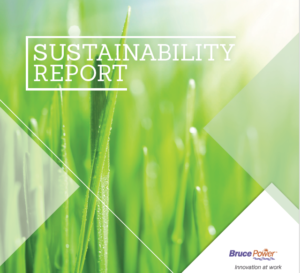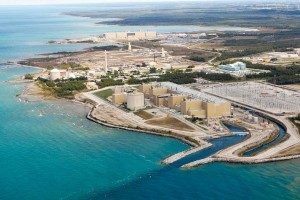Toolkit | Project
Nuclear Power Generation
Bruce Power: Toolkit Ambassador Releases First Sustainability Report
By: Kirsi McLandress, Sustainability Associate – Tavares Group Consulting Inc.
October, 2014
Bruce Power is the world’s largest nuclear operating site with the ability to generate 6,300 megawatts and is Ontario’s largest independent power generator, currently providing over 30% of Ontario’s electricity supply. Bruce Power’s facility includes two nuclear power generation stations, each containing 4 CANDU reactors. The facility, located in Tiverton Ontario on the shores of Lake Huron, directly employs 4,000 people. Safety first, coupled with environmental stewardship, community involvement and investment have been key priorities for the facility.
In t he fall of 2013, Bruce Power became one of the Sustainability Toolkit’s first Toolkit Ambassadors. As explained by Emily Johnston, Environmental and Sustainability – Corporate Affairs at Bruce Power, the main way in which the Toolkit has been used at Bruce Power has been to “focus our Corporate Sustainability planning process, and develop our first Sustainability Report.” In fact, in the summer of 2014 Bruce Power released its first Sustainability Report, using the Sustainability Toolkit’s four sustainability criteria to organize each section of its report.
he fall of 2013, Bruce Power became one of the Sustainability Toolkit’s first Toolkit Ambassadors. As explained by Emily Johnston, Environmental and Sustainability – Corporate Affairs at Bruce Power, the main way in which the Toolkit has been used at Bruce Power has been to “focus our Corporate Sustainability planning process, and develop our first Sustainability Report.” In fact, in the summer of 2014 Bruce Power released its first Sustainability Report, using the Sustainability Toolkit’s four sustainability criteria to organize each section of its report.
When asked how the Toolkit has helped Bruce Power’s sustainability program, the results, although still in a development phase, are significant.
On sustainability planning:
“The Toolkit has provided us with an excellent framework and is helping keep things on track and avoid distraction. It is also allowing us to define priorities with the confidence that these are based on and in alignment with industry standards and guidelines, and allowing us to focus effort on specific areas and workgroups.”
On stakeholder engagement and breaking down organizational silos:
“The Toolkit has helped advance the dialogue with different groups who have influence on the metrics. We are able to show them where they fit into the overall plan, and also often that we are not necessarily asking them to do additional work, but rather just enhance one aspect of the work they are already completing or even just share information with us.”
On why the Sustainability Toolkit has been a successful tool for Bruce Power:
“Compared to other “toolkits” the Sustainability Toolkit does not force you to conform to a specific standard but rather allows you to complement the standards your business already has in place. The Sustainability Toolkit outlined each of the metrics and gave us tangible examples of where we could start – I would consider it a bit of a launch point with open ended opportunity. It’s a launch point to gain buy-in from the wide variety of internal stakeholders. Our plan needed to be successful, and the Toolkit is a good reference to check back on when things got a bit hectic. The simplicity of this Toolkit is something that has allowed it to work in our facility.”
On how the Sustainability Toolkit is different than other products on the market today:
“Based on a review of various toolkits…there is a bit of a gap on addressing Corporate Culture and Change. Most toolkits discuss and outline all the metrics that have been researched and concluded necessary to make up a “Sustainable Business” but don’t provide specific guidance on how implementation can best be accomplished.”
 The Sustainability Toolkit Team is excited to continue working with Bruce Power in order to help them meet their sustainability goals.
The Sustainability Toolkit Team is excited to continue working with Bruce Power in order to help them meet their sustainability goals.



